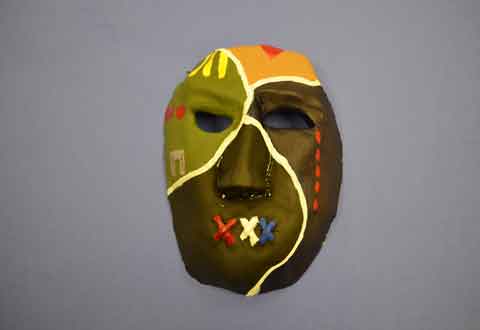Face Behind the Mask

A mask created by a Veteran who is participating with the Residential Rehabilitation Treatment Program's art therapy.
Humans have used masks from the beginning of time and for as many reasons as there were people.
VA Montana’s Residential Rehabilitation and Treatment Program (RRTP) has found a way to promote healing by using the ancient practice to put a face on modern Post Traumatic Stress Disorder (PTSD) through art therapy.
On Wednesday afternoon Mary "Chad" Atkins, the Behavioral Health Clinic's recreation and creative arts therapist, was working with a cohort of eight Veterans during the RRTP's six week PTSD program. She carefully placed red clay masks; each molded by the Veterans and fired at Helena’s Clay Arts Guild, on a table in one RRTP meeting room.
Next, she pushed an overloaded supply cart into the same room. Her makeshift studio was set. For the next two and a half hours, each owner used acrylics to paint his mask to represent his "Face of PTSD".
In 27 sessions covering three and a half years, Atkins has helped over 200 Veterans create masks to represent their struggle with PTSD. "No two are the same but I have seen common themes, like sealed mouths and alien features. The image speaks to them," Atkins said.
"Art therapy provides a non-verbal, creative means for individuals to explore psychological issues and themes that are otherwise not accessible at a conscious level," said Dr. Dudley Blake who heads the RRTP at the Behavioral Health Clinic at Fort Harrison.
"It was art therapy that moved my PTSD from me," said Atkins, of a painful experience she had as a teenager. From her experience, Atkins observed that some; especially creative people are more vulnerable to the effects of PTSD than others.
"People aren't always able to articulate their fears or conflicts, but this 'right-brain' therapy allows almost everyone a way to open up and express their innermost concerns and life issues," said Blake. Generally, the right side of the brain is thought to be best at expressive and creative tasks. Some of the abilities that are popularly associated with the right side of the brain include expressing and reading emotions, music, intuitiveness, and creativity.
Some Veterans keep their masks while others have destroyed what they created as a ritual to symbolize healing---a resolve to move beyond the PTSD that has stood in the way of their recovery. Other Veterans donate their work, where it serves as a reminder of another life touched.
While the masks have become a popular outlet to RRTP patients, Atkins' office is packed with art from the many other projects she oversees. One substance use disorders patient used a kite and a diorama to describe the things that had helped him "get high." Collages assembled from magazine clippings showed dark figures and troubled souls all seeking a way out. An arrow represented the pain that one Veteran had caused his loved ones.
"I became totally immersed in art therapy because I know the power," Atkins said.
When art therapy is coupled with other RRTP indoor and nature activities, patients are reengaged in their community, bond together, and regain a sense of wholeness, Atkins said.
















